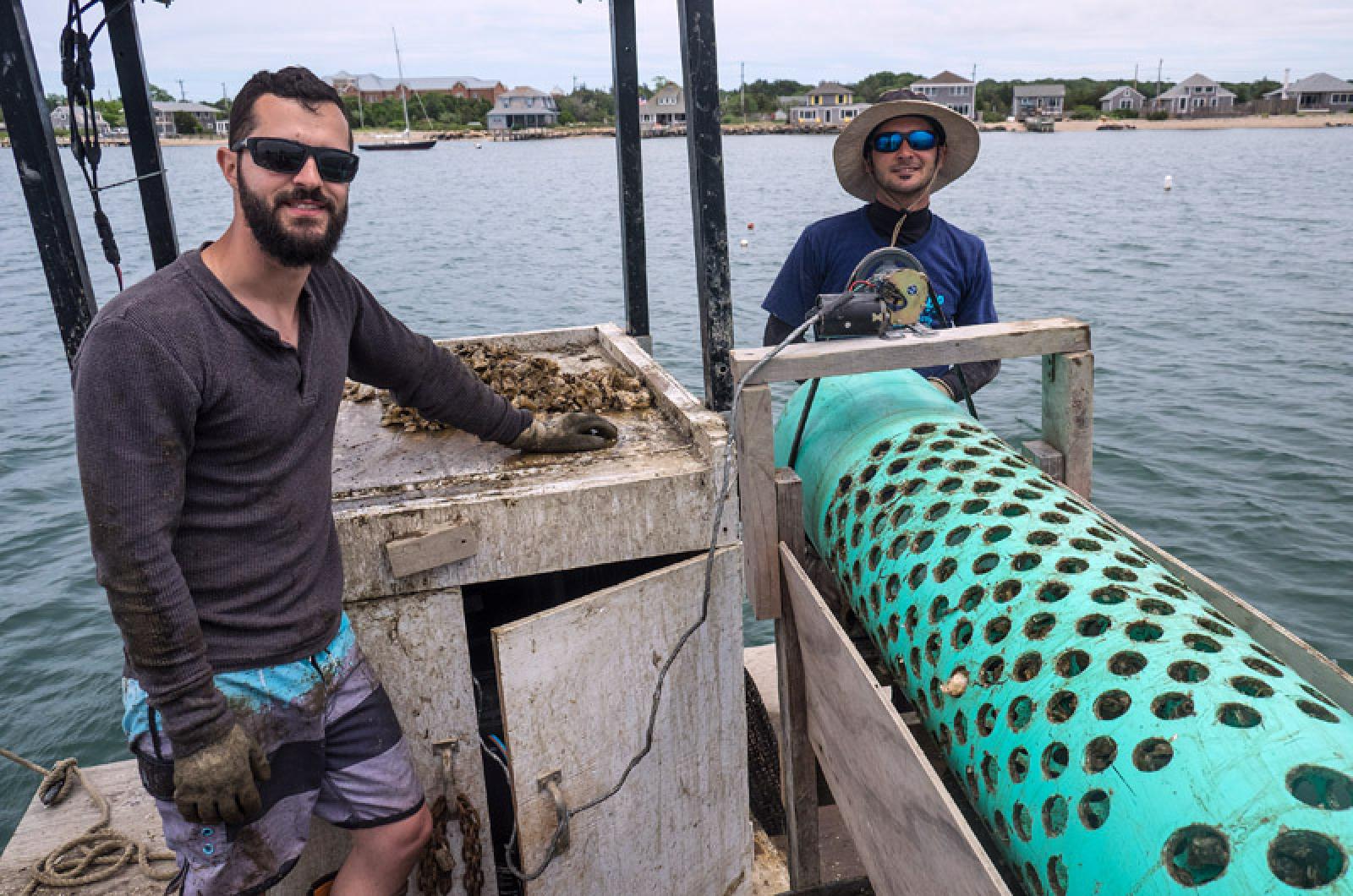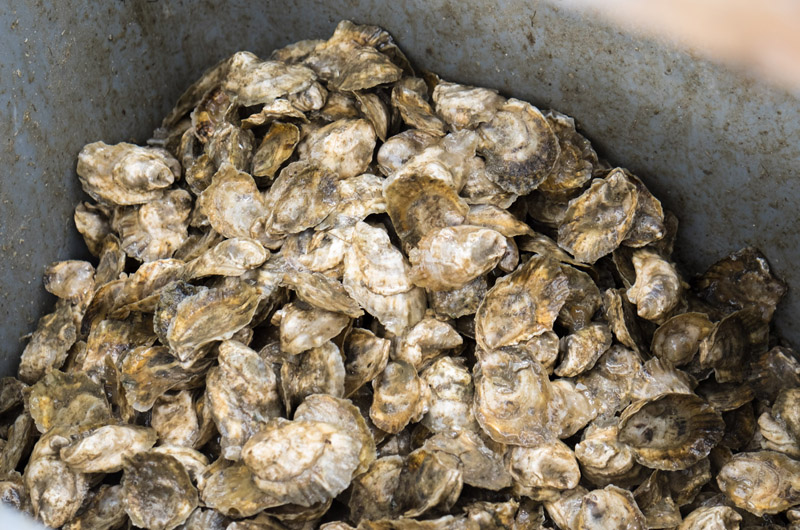Under a silvery gray sky this week, brothers Dan and Greg Martino motored out from Lagoon Pond, past the drawbridge and towering construction cranes on either side, and around the long stone jetty to their oyster farm off Eastville.
Once aboard the makeshift raft, stenciled with the words Cottage City Oysters on the sides, they settled into their usual rhythm, pulling up cages from the bottom and dumping out the young oysters onto a culling board to sort them by size. Eventually the oysters — still less than two inches long but golden and healthy looking — were returned to the sea floor to continue growing.
A small motor turned a long green tube, covered in holes and perched at an angle on the raft. Standing at the culling board at one end, Dan dropped in handfuls of oysters, which rolled around like raffle tickets and fell through the holes into plastic bins below. The different-sized holes sorted the oysters by size, and the rolling motion helped chip away the sharp edges of new growth, encouraging a more cupped shape suitable for market.
Nearly everything on the raft is handmade, including the raft itself — a point of pride for the brothers, ages 30 and 34, who spent more than five years developing and permitting the farm, which finally opened two years ago. Cottage City Oysters is still the Island’s only offshore oyster farm, making it something of an running experiment. And as another claim to fame, it is the only oyster farm in the state to run entirely on solar power.
Some of the equipment aboard the raft — including a power washer that draws water from the sea — was store-bought, but most of it was designed and built by the brothers themselves, with help from Jack Blake, an oyster farming pioneer on the Island who had inspired the brothers to pursue a career in aquaculture.
“That guy is one of the most innovative people I’ve ever met,” said older brother Dan, sorting through the baby oysters and pulling off smaller shells and other unwanted growth before dropping them in the tube. “He’s an inventor of everything.” Both brothers had worked for Mr. Blake on his farm in Katama Bay, where they soon realized their own future in aquaculture.
“It’s like the oh-[expletive] moment — when somebody pulls up a grown oyster out of the ocean and puts it in front of you,” said Greg, recalling his first trip to Katama Bay years ago. “It just kind of takes a hold of you and makes you want to be a part of that — and it’s obtainable.”
But it was perhaps less obtainable than they thought. The initial application before the town of Oak Bluffs in 2014 drew considerable opposition, especially from neighbors whose houses overlook the outer harbor from Eastville. The heat has long since died down, said Dan, and the little wooden raft surrounded by buoys seems as much a part of the waterway as the distant sails and regular ferries.
“We definitely went into this wanting to be the best neighbors we could,” said Dan, sorting through the oysters. “I think there is just a lot of misunderstanding about the nature of oyster farming in general and how organic it is.”
The two-acre farm now has about 50,000 oysters growing beneath the surface, feeding on the algae and phytoplankton carried in and out by the tides. This year’s crop is only the second so far, but appears to be thriving.
Last year was an experiment, with a goal of finding optimal densities for the sturdy mesh bags that hold the oysters. “You can overcrowd them and they won’t grow as much, or you can give them too much room and they won’t compete as much,” Greg said of the oysters. “That’s what we were working on last year — figuring out what densities they do best at. Now that we know that, we are getting great growth. This is better growth than we had last year.”
The crop is small by most standards, and has already sold out, leading the brothers to think about raising the bar for next year. Some of the oysters end up at private culinary events around the Island, while others are sold at The Net Result, just up the Beach Road in Vineyard Haven. All the oysters will stay on the Island, which Dan believes will benefit the Island community as a whole as money and resources ripple through the economy.
But not all of the 50,000 baby oysters will make it to market, and as demand increases, the harvests will likely increase as well. “We’d like to continue to gradually scale up,” said Dan.
“That’s been the challenge,” added Greg. “How many are going to come to market in a certain amount of time?” But uncertainty comes with the territory. “That’s farming, that’s everything,” he said.
One result of growing oysters in the open outer harbor has been a saltier, cleaner taste — perhaps as much a result of the different food sources as the saltier water. In any case, the brothers see it as a clear advantage in gaining a foothold in the Island seafood market.
“It’s very briny up front, with a clean finish that doesn’t linger at all,” Greg said describing the flavor of the oysters. “It pops and it’s done, and you just want another one because it’s such a clean finish.”
Just then, as if to punctuate the statement, a loud cannon blast echoed across the harbor, and a puff of smoke rose above the schooner Shenandoah, sailing just to the north. The towering ship was joined by a flotilla of smaller boats welcoming the Hawaiian voyaging canoe Hokule’a to the Vineyard on her world tour to promote sustainability. It was a fitting end to the workday.
Taking a quick break, the brothers sized up the much-revered double-hulled canoe as it approached Tisbury Wharf, towed by the fishing boat Julie’s Cat. The brothers said they felt lucky to be surrounded by such beauty and drama on their small raft. “It’s the best office you can have,” said Greg.
After switching off the motor and closing up shop, they climbed onto their own boat — cobbled together out of spare parts and piled high with empty oyster bags — and joined the others in welcoming the Hokule’a to port.









Comments (2)
Comments
Comment policy »